lock SKODA SUPERB 2003 1.G / (B5/3U) Manual PDF
[x] Cancel search | Manufacturer: SKODA, Model Year: 2003, Model line: SUPERB, Model: SKODA SUPERB 2003 1.G / (B5/3U)Pages: 259
Page 196 of 259

Care and cleaning195
Using the systemSafetyDriving TipsGeneral MaintenanceBreakdown assistanceTechnical Data
Leather cleaning and care
In view of the exclusiveness of the qualities and characteristics of the
leathers used (such as sensitivity to oils, greases, dirt etc.) a certain care-
fulness in use and particular care are required. Dark items of clothing, for
example, (particularly if these are moist and have poor quality dyeing)
may colour the leather seats. Dust and dirt particles in pores, creases and
seams may chafe and damage the surface. For this reason, care for the
leather regularly, or according to the wear-and-tear. After a lengthy period
of use, your leather seats will acquire a typical and unique patina. This is
characteristic of the natural product leather and is a sign of genuine
quality.
Please pay attention to the following notes in order to retain the value of
the natural material over its full life:
Caution
•Avoid leaving your vehicle for lengthy periods in bright sunlight in order
to avoid bleaching the leather. If you leave your vehicle parked in the open
for lengthy periods, protect the leather from the direct rays of the sun by
covering it over.
•Sharp-edged objects on items of clothing such as zip fasteners, rivets,
sharp-edged belts may leave permanent scratches or signs of rubbing on
the surface.
Note
•Use a care cream with light blocker and impregnation effect regularly
and each time after cleaning the leather. The cream nourishes the leather,
allows it to breathe and keeps it supple and also provides moisture. It also
creates surface protection.
•Clean the leather every 2 to 3 months, remove fresh soiling each time
this occurs.
•Remove fresh stains such as those from ball-point pens, ink, lipstick,
shoe cream etc., as quickly as possible.
•Care also for the leather dye. Refreshen areas which have lost their
colour with a special coloured leather cream as required.
Cleaning and care of leather upholstery
Normal cleaning
– Clean soiled areas of the leather with slightly moistened
cotton or woollen cloth.
Severe soiling
– Clean severely soiled areas with a cloth dipped in a mild soapy solution (2 spoonfuls of natural soap to 1 litre of water).
– Ensure that the leather is not soaked through at any point and that no water gets into the stitching of the seams.
– Dry off the leather with a soft, dry cloth.
Removing stains
– Remove fresh stains which are water-based (e.g. coffee, tea,
juices, blood etc.) with an absorbent cloth or household paper
or use the cleaner from the care set for a stain which has
already dried in.
– Remove fresh stains which are oil based (e.g. butter, mayon-
naise, chocolate etc.) with an absorbent cloth or household
cleaning paper or with the cleaner from the care set if the stain
has not yet penetrated into the surface.
– Use a grease dissolver for grease stains which have dried
in .
Page 197 of 259
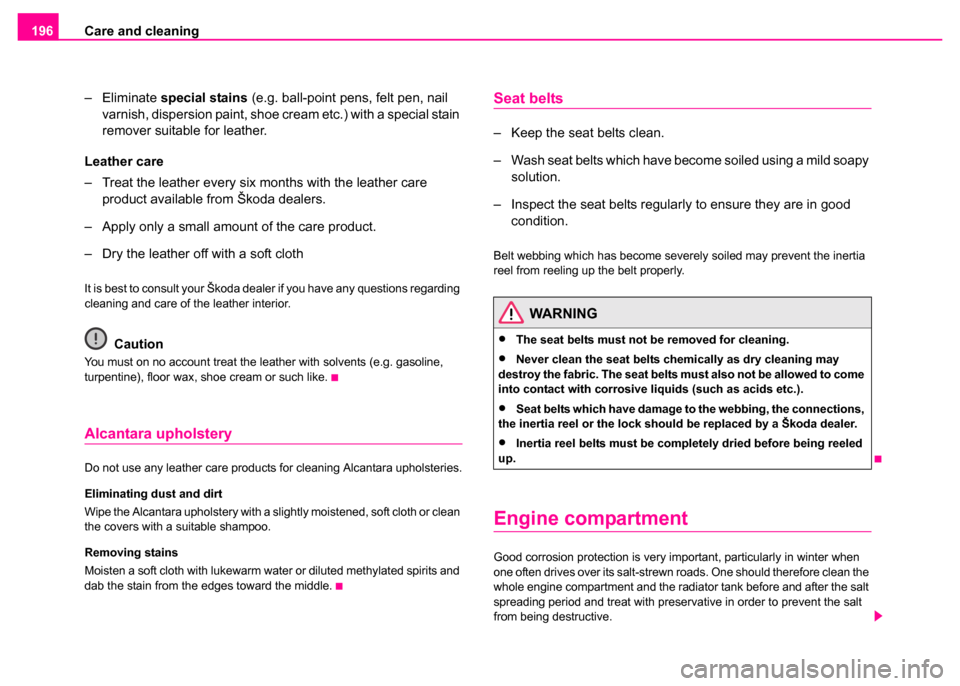
Care and cleaning
196
–Eliminate special stains (e.g. ball-point pens, felt pen, nail
varnish, dispersion paint, shoe cream etc.) with a special stain
remover suitable for leather.
Leather care
– Treat the leather every six months with the leather care product available from Škoda dealers.
– Apply only a small amount of the care product.
– Dry the leather off with a soft cloth
It is best to consult your Škoda dealer if you have any questions regarding
cleaning and care of the leather interior.
Caution
You must on no account treat the leather with solvents (e.g. gasoline,
turpentine), floor wax, shoe cream or such like.
Alcantara upholstery
Do not use any leather care products for cleaning Alcantara upholsteries.
Eliminating dust and dirt
Wipe the Alcantara upholstery with a slightly moistened, soft cloth or clean
the covers with a suitable shampoo.
Removing stains
Moisten a soft cloth with lukewarm water or diluted methylated spirits and
dab the stain from the edges toward the middle.
Seat belts
– Keep the seat belts clean.
– Wash seat belts which have become soiled using a mild soapy solution.
– Inspect the seat belts regularly to ensure they are in good condition.
Belt webbing which has become severely soiled may prevent the inertia
reel from reeling up the belt properly.
Engine compartment
Good corrosion protection is very important, particularly in winter when
one often drives over its salt-strewn roads. One should therefore clean the
whole engine compartment and the radiator tank before and after the salt
spreading period and treat with preservative in order to prevent the salt
from being destructive.
WARNING
•The seat belts must not be removed for cleaning.
•Never clean the seat belts chemically as dry cleaning may
destroy the fabric. The seat belts must also not be allowed to come
into contact with corrosive liquids (such as acids etc.).
•Seat belts which have damage to the webbing, the connections,
the inertia reel or the lock should be replaced by a Škoda dealer.
•Inertia reel belts must be completely dried before being reeled
up.
Page 201 of 259
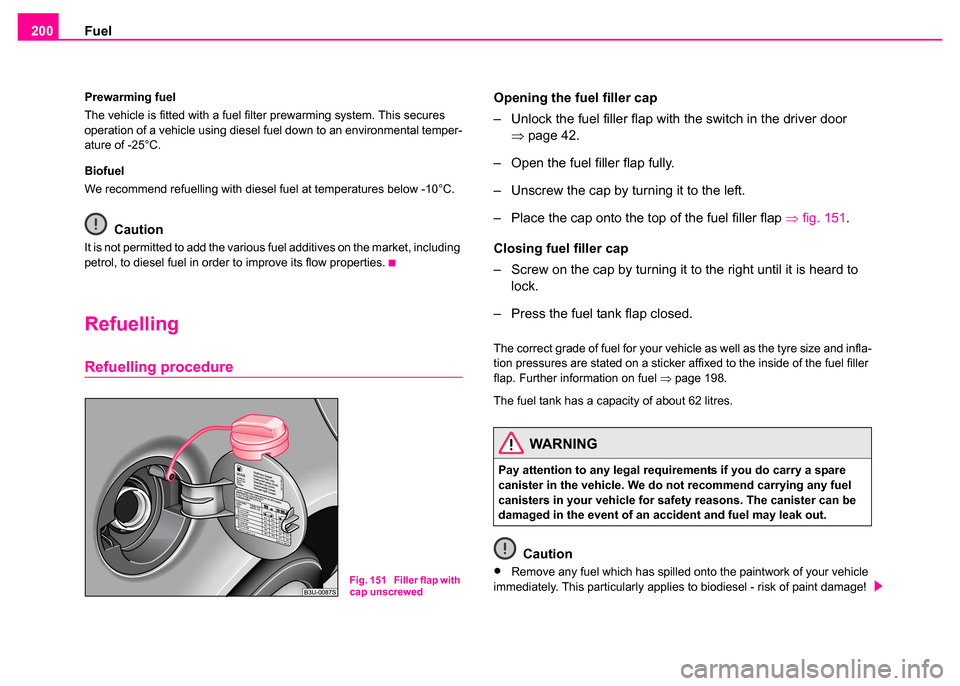
Fuel
200
Prewarming fuel
The vehicle is fitted with a fuel filter prewarming system. This secures
operation of a vehicle using diesel fuel down to an environmental temper-
ature of -25°C.
Biofuel
We recommend refuelling with diesel fuel at temperatures below -10°C.
Caution
It is not permitted to add the various fuel additives on the market, including
petrol, to diesel fuel in order to improve its flow properties.
Refuelling
Refuelling procedure
Opening the fuel filler cap
– Unlock the fuel filler flap with the switch in the driver door
⇒page 42.
– Open the fuel filler flap fully.
– Unscrew the cap by turning it to the left.
– Place the cap onto the top of the fuel filler flap ⇒fig. 151.
Closing fuel filler cap
– Screw on the cap by turning it to the right until it is heard to lock.
– Press the fuel tank flap closed.
The correct grade of fuel for your vehicle as well as the tyre size and infla-
tion pressures are stated on a sticker affixed to the inside of the fuel filler
flap. Further information on fuel ⇒page 198.
The fuel tank has a capacity of about 62 litres.
Caution
•Remove any fuel which has spilled onto the paintwork of your vehicle
immediately. This particularly applies to biodiesel - risk of paint damage!Fig. 151 Filler flap with
cap unscrewed
WARNING
Pay attention to any legal requirements if you do carry a spare
canister in the vehicle. We do not recommend carrying any fuel
canisters in your vehicle for safety reasons. The canister can be
damaged in the event of an accident and fuel may leak out.
Page 202 of 259

Fuel201
Using the systemSafetyDriving TipsGeneral MaintenanceBreakdown assistanceTechnical Data
•Vehicles fitted with catalytic converter should never be allowed to let
the fuel tank to run completely empty. An irregular supply of fuel to the
engine can result in misfiring and unburnt fuel may get into the exhaust
system, which may result in overheating and damage to the catalytic
converter.
For the sake of the environment
The fuel tank is full just as soon as the pump nozzle switches off for the
first time, provided the nozzle has been operated properly. You should not
continue refuelling - otherwise the expansion chamber in the fuel tank will
also be filled with fuel. Fuel might flow out of the tank when it heats up.
Emergency release of fuel filler flap
If the electric lock is faulty, you can also unlock the fuel filler flap
manually. – Open the boot lid/luggage compartment door.
– Unscrew the clip attaching the right-hand side trim panel and
pull the trim panel off the body.
– Pull on the loop in direction of arrow in order to unlock the fuel filler flap ⇒fig. 152 .
Fig. 152 Luggage
compartment: Emer-
gency release of fuel
filler flap
WARNING
Reel up the belt webbing once again until it is fitted snugly against
the child seat.
Page 203 of 259
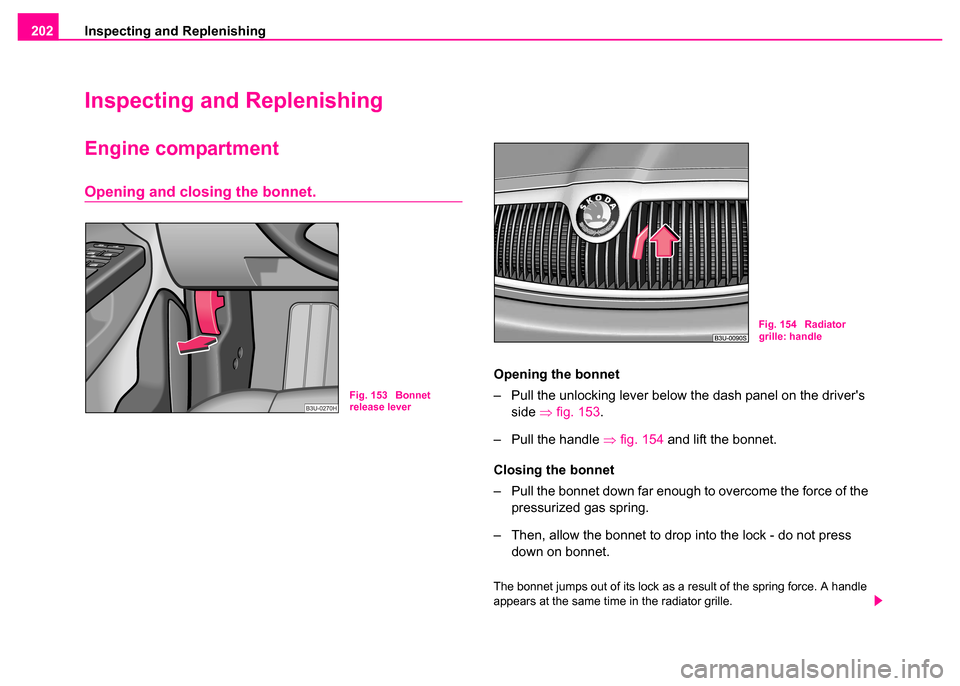
Inspecting and Replenishing
202
Inspecting and Replenishing
Engine compartment
Opening and closing the bonnet.
Opening the bonnet
– Pull the unlocking lever below the dash panel on the driver's
side ⇒fig. 153 .
– Pull the handle ⇒fig. 154 and lift the bonnet.
Closing the bonnet
– Pull the bonnet down far enough to overcome the force of the pressurized gas spring.
– Then, allow the bonnet to drop into the lock - do not press down on bonnet.
The bonnet jumps out of its lock as a result of the spring force. A handle
appears at the same time in the radiator grille.
Fig. 153 Bonnet
release lever
Fig. 154 Radiator
grille: handle
Page 204 of 259
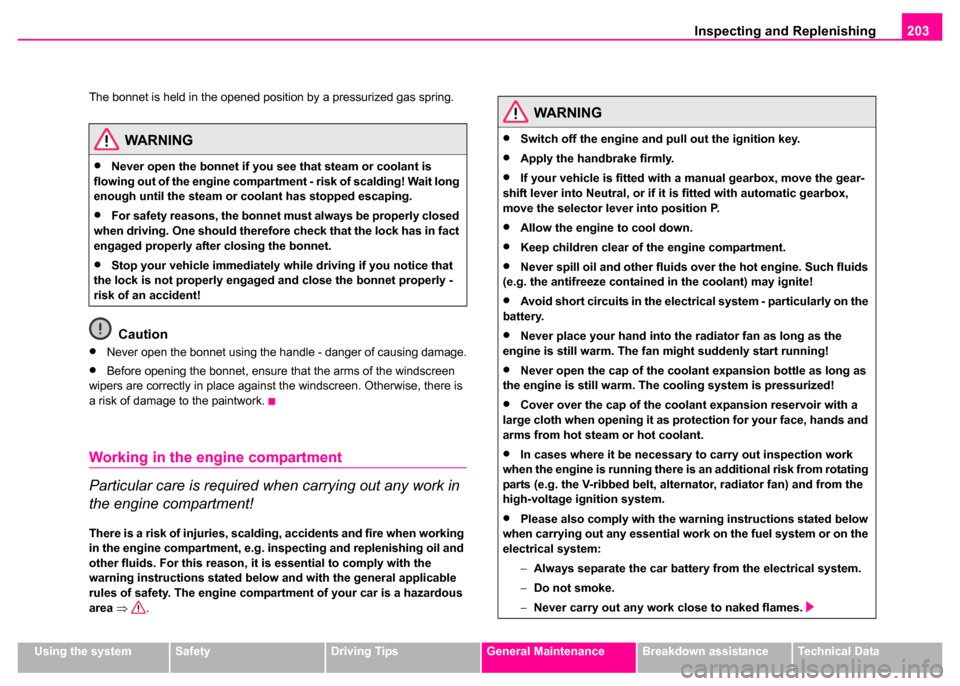
Inspecting and Replenishing203
Using the systemSafetyDriving TipsGeneral MaintenanceBreakdown assistanceTechnical Data
The bonnet is held in the opened position by a pressurized gas spring.
Caution
•Never open the bonnet using the handle - danger of causing damage.
•Before opening the bonnet, ensure that the arms of the windscreen
wipers are correctly in place against the windscreen. Otherwise, there is
a risk of damage to the paintwork.
Working in the en gine compartment
Particular care is required when carrying out any work in
the engine compartment!
There is a risk of injuries, scalding , accidents and fire when working
in the engine compartment, e.g. inspecting and replenishing oil and
other fluids. For this reason, it is essential to comply with the
warning instructions st ated below and with the general applicable
rules of safety. The engine compartment of your car is a hazardous
area ⇒ .
WARNING
•Never open the bonnet if you see that steam or coolant is
flowing out of the engine compartmen t - risk of scalding! Wait long
enough until the steam or coolant has stopped escaping.
•For safety reasons, the bonnet must always be properly closed
when driving. One should therefore check that the lock has in fact
engaged properly after closing the bonnet.
•Stop your vehicle immediately wh ile driving if you notice that
the lock is not properly engaged and close the bonnet properly -
risk of an accident!
WARNING
•Switch off the engine and pull out the ignition key.
•Apply the handbrake firmly.
•If your vehicle is fitted with a manual gearbox, move the gear-
shift lever into Neutral, or if it is fitted with automatic gearbox,
move the selector lever into position P.
•Allow the engine to cool down.
•Keep children clear of the engine compartment.
•Never spill oil and other fluids over the hot engine. Such fluids
(e.g. the antifreeze contained in the coolant) may ignite!
•Avoid short circuits in the electrical system - particularly on the
battery.
•Never place your hand into the radiator fan as long as the
engine is still warm. The fan might suddenly start running!
•Never open the cap of the coolant expansion bottle as long as
the engine is still warm. The cooling system is pressurized!
•Cover over the cap of the coolant expansion reservoir with a
large cloth when opening it as protection for your face, hands and
arms from hot steam or hot coolant.
•In cases where it be necessary to carry out inspection work
when the engine is running there is an additional risk from rotating
parts (e.g. the V-ribbed belt, alternator, radiator fan) and from the
high-voltage ignition system.
•Please also comply with the warning instructions stated below
when carrying out any essential work on the fuel system or on the
electrical system:
−Always separate the car battery from the electrical system.
− Do not smoke.
− Never carry out any work close to naked flames.
Page 210 of 259

Inspecting and Replenishing209
Using the systemSafetyDriving TipsGeneral MaintenanceBreakdown assistanceTechnical Data
– Open the bonnet ⇒ in “Working in the engine compart-
ment” on page 203.
– Check the level of coolant in the coolant expansion bottle ⇒fig. 157. The coolant level when the engine is cold must lie
between the “MIN” and “MAX” markings. The level may also
rise slightly above the “MAX” marking when the engine is
warm.
If the coolant level in the reservoir is too low, this is indicated by the
warning light in the instrument cluster ⇒ page 28. We nevertheless
recommend inspecting the coolant level directly at the reservoir from time
to time.
Loss of coolant
A loss of coolant is first and foremost an indication of a leak in the
system. You should not merely top up the coolant in the reservoir. It is also
important to have the cooling system inspected without delay by a Škoda
dealer.
Losses can only occur through the pressure relief in the cap of the coolant
expansion bottle which is completely free of leaks if the coolant boils as a
result of overheating and is forced out of the cooling system.
One should contact a Skoda dealer as soon as possible if the source of
overheating itself cannot be determined and removed, since there may be
grave damage to the engine.
Replenishing the coolant
– Switch the engine off.
– Allow the engine to cool down. – Place a cloth over the cap of the coolant expansion reservoir
⇒page 208, fig. 157 and unscrew the cap carefully by
turning it to the left ⇒.
– Top up the coolant.
– Screw on the cap tight until it is heard to lock.
The coolant which you use for replenishing the system, must comply with
certain specifications ⇒page 208, “Coolant”. Do not use an alternative
additive if the coolant additive G12°PLUS is not available in exceptional
cases. Just top up the system with water and as soon as possible arrange
adjustment to correct the mixing ratio of water and coolant additive again
by a Škoda dealer.
Only use fresh coolant for topping up the system.
Do not fill up over the “MAX” marking! Excess coolant which is heated up
is forced out of the cooling system through the pressure relief valve in the
cap of the coolant compensation bottle.
Wait until the engine has cooled down for a system which has suffered a
major loss of coolant before pouring in coolant. This is necessary to avoid
engine damage.
Do not continue your journey if for some reason it is not possible
under the conditions prevailing to top up with coolant. Switch off the
engine and obtain professional assistance from a Škoda dealer.
WARNING
•The cooling system is pressurized! Do not open the cap of the
coolant expansion bottle if the engine is still hot - risk of
scalding!
Page 217 of 259
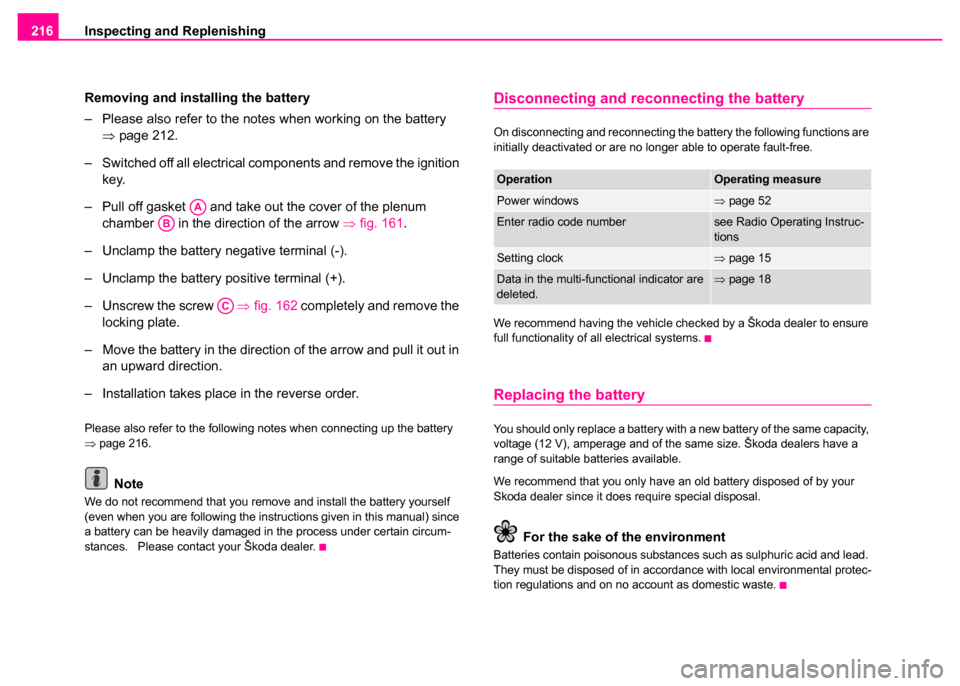
Inspecting and Replenishing
216
Removing and installing the battery
– Please also refer to the notes when working on the battery ⇒page 212.
– Switched off all electrical components and remove the ignition key.
– Pull off gasket and take out the cover of the plenum chamber in the direction of the arrow ⇒fig. 161 .
– Unclamp the battery negative terminal (-).
– Unclamp the battery positive terminal (+).
– Unscrew the screw ⇒fig. 162 completely and remove the
locking plate.
– Move the battery in the direction of the arrow and pull it out in an upward direction.
– Installation takes place in the reverse order.
Please also refer to the following notes when connecting up the battery
⇒ page 216.
Note
We do not recommend that you remove and install the battery yourself
(even when you are following the instructions given in this manual) since
a battery can be heavily damaged in the process under certain circum-
stances. Please contact your Škoda dealer.
Disconnecting and reconnecting the battery
On disconnecting and reconnecting the battery the following functions are
initially deactivated or are no longer able to operate fault-free.
We recommend having the vehicle checked by a Škoda dealer to ensure
full functionality of all electrical systems.
Replacing the battery
You should only replace a battery with a new battery of the same capacity,
voltage (12 V), amperage and of the same size. Škoda dealers have a
range of suitable batteries available.
We recommend that you only have an old battery disposed of by your
Skoda dealer since it does require special disposal.
For the sake of the environment
Batteries contain poisonous substances such as sulphuric acid and lead.
They must be disposed of in accordance with local environmental protec-
tion regulations and on no account as domestic waste.
AA
AB
AC
OperationOperating measure
Power windows⇒page 52
Enter radio code numbersee Radio Operating Instruc-
tions
Setting clock⇒page 15
Data in the multi-functional indicator are
deleted.⇒page 18
Page 226 of 259

Wheels and Tyres225
Using the systemSafetyDriving TipsGeneral MaintenanceBreakdown assistanceTechnical Data
Unidirectional tyres*
The direction of rotation of the tyres is marked by arrows on the wall of
the tyre . This indicates the direction of rotation of the tyre, and it is essen-
tial that the tyres are fitted on to run in this direction. Only then are the
tyres able to provide the optimal properties in terms of grip, low noise,
wear-and-tear and aquaplaning.
Should it be necessary to fit on a spare wheel in exceptional cases with a
tyre not dedicated to the running direction, please adopt a cautious style
of driving as the tyre is no longer able to provide optimal grip and handling
in such a situation. This particularly important on wet roads. Please refer
to the notes ⇒page 229.
You should have the defective tyre replaced as soon as possible and
restore the correct direction of rotation on all tyres
Snow chains
Snow chains can be used only for wheel sizes 6J x 16 ET 40 or 6J x 16
ET 37. Your Škoda Dealer can provide you with more detailed information.
Snow chains must only be mounted on the front wheels.
When driving on wintry roads, snow chains improve not only traction, but
also the braking performance.
Only use fine-link snow chains . They must not project more than 15 mm
- including the chain lock.
Remove the full wheel trim if you wish to fit snow chains to the wheels.
You must take the chains off as soon as you drive on roads which are free
of snow. They adversely affect the handling of your vehicle, damage the
tyres and are rapidly destroyed. Observe the national legal requirements relating to the maximum vehicle
speed with snow chains.
Note
We recommend that you use snow chains from the Škoda range of
genuine accessories.
Page 228 of 259

Breakdown assistance227
Using the systemSafetyDriving TipsGeneral MaintenanceBreakdown assistanceTechnical Data
Breakdown assistance
Breakdown assistance
First-aid box*
First-aid box
The compartment for stowing the first-aid box is located in the left of the
luggage compartment ⇒fig. 168 .
Note
Pay attention to the use-by-date of the contents of the first-aid box.
Warning triangle
– To remove the warning triangle, turn the rotary lock in direc-
tion of arrow ⇒fig. 169 and fold the fixture down.
Fig. 168 Compartment
for stowing first-aid
boxFig. 169 Warning
triangle fitted inside
boot lid